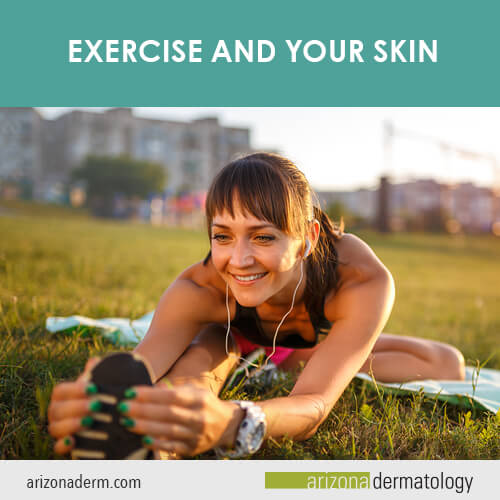 Have you adjusted your exercise routine and wonder if that has something to do with changes to your skin? It might.
Have you adjusted your exercise routine and wonder if that has something to do with changes to your skin? It might.
Working out can have effects, both positive and negative, on your skin. Let’s take a look at the benefits first.
Benefits of Exercise on Your Skin
An after-workout “glow.” If you think your skin looks better after a workout, it’s not just the endorphins working on your brain. Raising your heart rate improves circulation throughout the body, including to your skin. Add the “glistening” effect of a layer of sweat, and your skin’s radiance factor goes up.
Keeps skin healthy. Better blood flow doesn’t just make you look good right after your workout, it delivers oxygen and nutrients to the skin, helping skin to repair itself, promoting the production of new skin cells, and feeding the mechanisms that boost collagen production. The result: a brighter, more youthful complexion.
Sweating is good for your skin. Sweat does a number of things for your skin in addition to giving you a temporary glow. It directly hydrates skin while also clearing the pores of dirt, bacteria and oil. Sweat also contains an antimicrobial peptide (dermicidin) that wards off harmful bacteria that can cause infections.
Inflammation reduction. No matter whether you are lifting weights or doing strictly cardio, working out reduces stress hormones and releases anti-inflammatory proteins. This can have a positive impact on inflammatory skin disorders like acne and eczema.
Anti-aging. Believe it or not, exercising can slow or even reverse the signs of skin aging. A study by McMaster University found evidence that exercise prevents non-sun-damaged skin from age-related changes on a cellular level. Even participants who began exercising later in life showed a reversal in signs of skin aging under the microscope. Another McMaster study showed that exercise prompts mitochondrial changes in the skin that can make it appear up to 25 times younger at a microscopic level.
Noticeable changes. Odds are you’re not going to see these microscopic changes when you look in the mirror, but after three to six months of regular exercise, you may notice your complexion is smoother and brighter. Of course, the results won’t be as dramatic (or quick) as having a facial rejuvenation procedure, but your skin will be healthier in the long run.
What to Watch out For
Sun exposure. Unfortunately, any anti-aging benefits that exercise offers are easily counteracted by a very powerful nemesis: the sun. Not only that, but outdoor exercise can raise your risk of skin cancer. If you want to work out outdoors, morning and evenings are best, and don’t forget to use a sunscreen with an SPF of 30 or higher on all areas of exposed skin. Apply your sunscreen at least 15 minutes before heading outside, and since you’ll likely be sweating, a water-resistant sunscreen is the way to go.
Sweat. Wait, didn’t we just say sweat is good for your skin? In the moment, yes, but as the water in sweat evaporates, all those impurities are left sitting on your skin, which can clog pores and cause acne breakouts. If you have acne-prone skin, wash your face before and after a workout to minimize the risk. No matter what skin type you have, an after-workout shower is a must to wash away dirt and oil before they can infiltrate your pores. Not to mention the body odor you experience after exercising is actually the result of bacteria on your skin feeding on the components of your sweat. That should make you think twice before skipping the shower!
Irritation. During exercise, friction from clothing or skin chafing can cause irritation or rash. To combat this, apply a strong antiperspirant to the affected area or liberally apply a moisturizing ointment. If you tend to get rashes in folds of skin (like the inner thighs, buttocks or under the breasts), dry those areas well during exercise and after your post-workout shower so you don’t end up with intertrigo, an itchy, red rash caused by overgrowth of yeast.
Rosacea. Unfortunately, since rosacea is a vascular condition, increased blood flow to the skin can worsen its symptoms. Your dermatologist can help you manage rosacea with medications, skin care products and laser treatments, but if working out is causing problematic flare-ups, try these tips. 1) Stick to moderate intensity rather than high intensity workouts. 2) Exercise in short spurts rather than for one long time period. 3) Avoid overheating. 4) Stay hydrated. 5) Keep a spray bottle of cold water or a cool, wet towel near you to apply to your face during workouts.
Overall, the benefits of exercise far outweigh the risks to your skin. If skin conditions are making it difficult for you to stay in shape, talk to your dermatologist.


